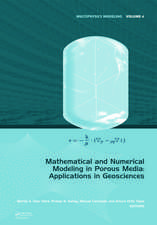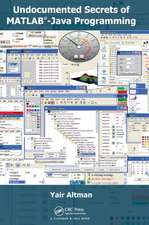Methods for Solving Incorrectly Posed Problems
Autor V. A. Morozov Editat de Z. Nashed Traducere de A.B. Ariesen Limba Engleză Paperback – 20 noi 1984
Preț: 384.36 lei
Nou
Puncte Express: 577
Preț estimativ în valută:
73.61€ • 75.84$ • 61.66£
73.61€ • 75.84$ • 61.66£
Carte tipărită la comandă
Livrare economică 24 februarie-10 martie
Preluare comenzi: 021 569.72.76
Specificații
ISBN-13: 9780387960593
ISBN-10: 0387960597
Pagini: 257
Ilustrații: 257 p.
Dimensiuni: 155 x 235 x 15 mm
Greutate: 0.4 kg
Ediția:Softcover reprint of the original 1st ed. 1984
Editura: Springer
Colecția Springer
Locul publicării:New York, NY, United States
ISBN-10: 0387960597
Pagini: 257
Ilustrații: 257 p.
Dimensiuni: 155 x 235 x 15 mm
Greutate: 0.4 kg
Ediția:Softcover reprint of the original 1st ed. 1984
Editura: Springer
Colecția Springer
Locul publicării:New York, NY, United States
Public țintă
ResearchCuprins
1. The Regularization Method.- Section 1. The Basic Problem for Linear Operators.- Section 2. The Approximation of the Solution of the Basic Problem.- Section 3. The Euler Variation Inequality. Estimation of Accuracy.- Section 4. Stability of Regularized Solutions.- Section 5. Approximation of the Admissible Set. Choice of the Basis.- 2. Criteria for Selection of Regularization Parameter.- Section 6. Some Properties of Regularized Solutions.- Section 7. Methods for Choosing the Parameter: Case of Exact Information.- Section 8. The Residual Method and the Method of Quasi-solutions: Case of Exact Information.- Section 9. Properties of the Auxiliary Functions.- Section 10. Criteria for the Choice of a Parameter: Case of Inexact Data.- 3. Regular Methods for Solving Linear and Nonlinear Ill-Posed Problems.- Section 11. Regularity of Approximation Methods.- Section 12. The Theory of Accuracy of Regular Methods.- Section 13. The Computation of the Estimation Function.- Section 14. Examples of Regular Methods.- Section 15. The Principle of Residual Optimality for Approximate Solutions of Equations with Nonlinear Operators.- Section 16. The Regularization Method for Nonlinear Equations.- 4. The Problem of Computation and the General Theory of Splines.- Section 17. The Problem of Computation and the Parameter Identification Problem.- Section 18. Properties of Smoothing Families of Operators.- Section 19. The Optimality of Smoothing Algorithms.- Section 20. The Differentiation Problem and Algorithms of Approximation of the Experimental Data.- Section 21.The Theory of Splines and the Problem of Stable Computation of Values of an Unbounded Operator.- Section 22. Approximate Solution of Operator Equations Using Splines.- Section 23. Recovering the Solution of the Basic Problem FromApproximate Values of the Functiona1s.- 5. Regular Methods for Special Cases of the Basic Problem. Algorithms for Choosing the Regularization Parameter.- Section 24. Pseudosolutions.- Section 25. Optimal Regularization.- Section 26. Numerical Algorithms for Regularization Parameters.- Section 27. Heuristic Methods for Choosing a Parameter.- Section 28. The Investigation of Adequacy of Mathematical Models.










